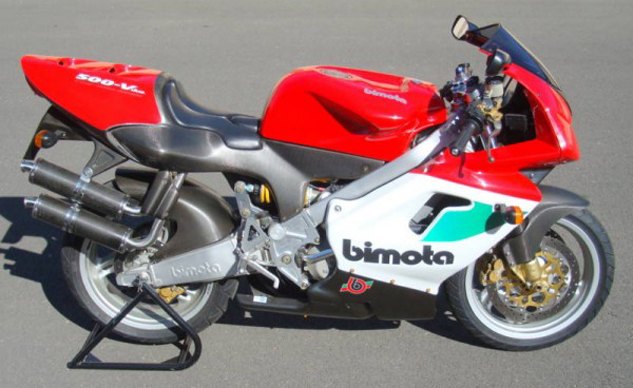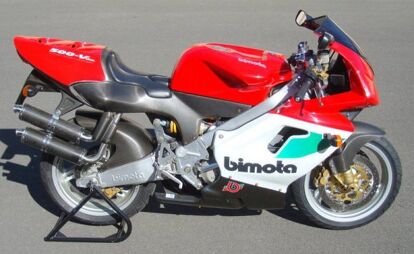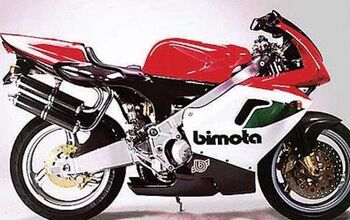Church Of MO – 1997 Bimota 500 V Due

Hello and welcome to yet another installment of the Church of MO. Every Sunday we’ll take a look back in the MO vault for stories, maybe forgotten, deserving of revival. For this, our second week, we pay homage to the 1997 Bimota 500 V Due, one of the last two-stroke production motorcycles to be sold stateside, made even more unique because of the technology it employed and the cult following it still enjoys. Now, here’s Colin MacKellar with the story of one of motorcycling’s more obscure models.
1997 Bimota 500 V Due
Early next year a milestone will be written into the history books when series production starts on the first two-stroke motorcycle in more than 10 years to meet the EPA requirements of all 50 states in the USA, and anywhere else in the world for that matter. And what a motorcycle it will be. Bimota, the constructors of the most exclusive sport bikes in the world, will unleash their 500cc two-stroke V-twin, dressed to kill in full race-tech livery. This bike will have sport riders’ pulse rates racing into overload — before they even get into the saddle. The Due will obviously be competing for the title of Ultimate Sports Machine.
Bimota has spent over six years developing this wonderful piece of machinery, not surprising since the R&D department has never had more than single figure staffing levels. Traditionally Bimota has borrowed powerplants from their Far Eastern industrial colleagues and wrapped them in exquisitely crafted frames and bodywork. Recent Bimota models have seen increasing applications of fuel injection to the engines, and this has served as the proving ground for the development of the Direct Injected two-stroke engine.
Interest in two-stroke power plants has been widespread within the motorcycle and auto industry for the last 10 years, sparked by the development of a new breed of fuel injectors by the Australian company Orbital. The new system provided a granularity of fuel atomization that made their application in a two-stroke engine a practicality. Two-strokes are of interest to the automotive industry due to their simplicity and high power-to-weight ratio – if only they weren’t so dirty and fuel inefficient. Both these phenomena are caused by the two-stroke principle of using fresh, fuel-rich intake air to clean or scavenge the cylinder of exhaust gases. The tuned exhaust systems try and prevent much of this charge from escaping out of the cylinder with the exhaust gases, but a lot still does. With direct injected fuel, this is no longer a problem as air can be used to expel the exhaust gas, and the injectors only fire at the moment the exhaust ports have closed. Result is nice clean exhausts, free of unburned hydrocarbons, and un-polluted clean fresh charge waiting for the big bang of the next ignition pulse. Two-stroke heaven.
The exact configuration of the fuel injection system is not yet known for the Bimota, but it seems that they have chosen to scavenge the exhaust gases by pumping fresh air through the crankcase and the conventional two-stroke transfer ports. Reed valves are still used to regulate the flow of air into the cylinder, each cylinder being supplied through a separate reed block. There are six transfer ports and three exhaust ports, a common configuration for contemporary two-strokes. The fuel injection system will be linked into an engine management system that checks many of the factors that influence the amount of fuel to be injected, including air temperature, water temperature, exhaust gas temperature and airbox pressure.
Another major contribution to the clean exhaust of the Due is the use of the gearbox oil to lubricate the main bearings, rather than relying on the fuel/oil mist of regular two-strokes. Cylinder and crankshaft lubrication is still performed by two-stroke oil, flowing down small galleries into the guts of the engine. There is a two liter oil tank partition to the fuel tank that will need very infrequent topping up.
The racing heritage of the machine is obvious, with a hydraulically-actuated dry clutch and 6-speed side-loading cassette gearbox that will come in handy if you want change your gearing for your favorite set of curves. The frame follows Bimota’s recent preference for oval profile alloy pipes, with an Ohlins rear shock and 46mm Paioli fully adjustable front forks. Carbon cans keep the exhaust note muted and carbon fiber is also used for the seat. Brembo discs, Antera alloy wheels and Michelin Hi-Sport radial tires complete the list of top range equipment.
Talking to the Bimota staff at the recent IFMA show in Cologne, they made it clear they wanted to start production as soon as possible, and were hoping for an initial production run of 500 units. This may not seem like a lot, but when you consider that last year Bimota produced less than 1500 bikes, it represents a massive part of their operation. Further questioning revealed that the bike was quite literally not ready for the show until the last minute, and some inconsistencies between spec sheets suggest that it may not yet be ready for full production. On the other hand, now that the project has got as far as it has, Bimota will want to start production as soon as possible to start recouping the enormous investment they have made in the new engine technology.
Specifications:
Engine
Manufacturer: Bimota Model: 500 V due - 2 tempi Iniezone Elettronica Engine: Liquid-cooled, Two-stroke V-twinBore x stroke: 72 x 61.25 mmDisplacement: 499 ccCompression Ratio: 12:1Carburation: Twin injectorsMax power: 110 HP @ 9,000 rpmMax torque: 9 Kgm @ 8,000 rpm
Chassis
Frame: Aluminum alloy pipes with oval cross-sectionWheelbase: 1340 mmRake: 23°Trail: 89 mmFront Brake: Brembo double discsRear Brake: single discWheels: 3.50x17 front - 5.50x17 rear
Dimensions
Max Length: 1940 mmSeat Height: 790 mmFuel Capacity: 20 LClaimed dry Weight: <150 Kg

Troy's been riding motorcycles and writing about them since 2006, getting his start at Rider Magazine. From there, he moved to Sport Rider Magazine before finally landing at Motorcycle.com in 2011. A lifelong gearhead who didn't fully immerse himself in motorcycles until his teenage years, Troy's interests have always been in technology, performance, and going fast. Naturally, racing was the perfect avenue to combine all three. Troy has been racing nearly as long as he's been riding and has competed at the AMA national level. He's also won multiple club races throughout the country, culminating in a Utah Sport Bike Association championship in 2011. He has been invited as a guest instructor for the Yamaha Champions Riding School, and when he's not out riding, he's either wrenching on bikes or watching MotoGP.
More by Troy Siahaan



































Comments
Join the conversation
what a letdown. I do still have the t-shirt in my drawer i believe...
I would rather have one of the Ducati based Bimotas. The is a perfect example of a V Due that shows up about once a year at the Beale Street bike night in Memphis. the guys has a bunch of exotic stuff and only takes things out every once in a while. IIRC the v Due does not run very well and has major fueling issues.